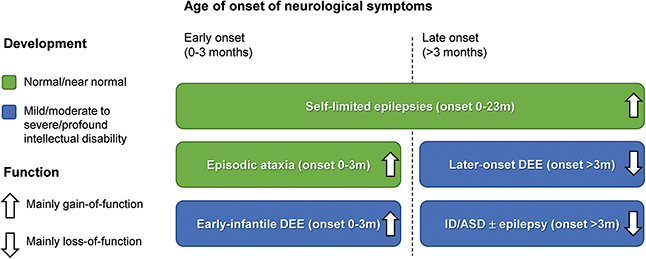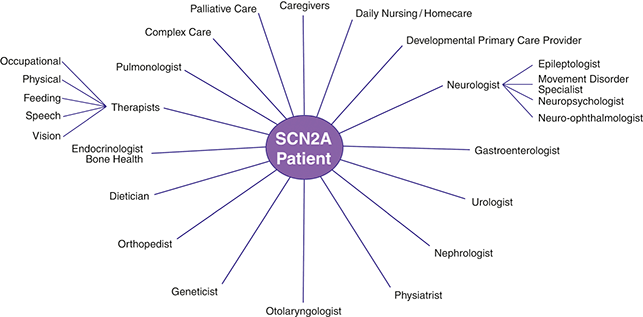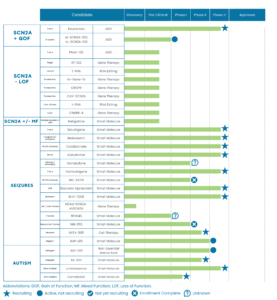Clinical Information for Professionals
Comprehensive resources to help clinicians and other professionals working with people with SRDs.
SCN2A Resources for Clinicians
"SCN2A encodes a voltage-gated sodium channel (designated NaV1.2) vital for generating neuronal action potentials. Pathogenic SCN2A variants are associated with a diverse array of neurodevelopmental disorders featuring neonatal or infantile onset epilepsy, developmental delay, autism, intellectual disability and movement disorders. SCN2A is a high confidence risk gene for autism spectrum disorder and a commonly discovered cause of neonatal onset epilepsy. This remarkable clinical heterogeneity is mirrored by extensive allelic heterogeneity and complex genotype-phenotype relationships partially explained by divergent functional consequences of pathogenic variants. Emerging therapeutic strategies targeted to specific patterns of NaV1.2 dysfunction offer hope to improve the lives of individuals affected by SCN2A-related disorders.”
2024 Cambridge Elements - Genetics in Epilepsy - SCN2A-Related Disorders
Key Considerations
Presentation
- SCN2A presents with multiple phenotypes, including DEE (Developmental and Epileptic Encephalopathy), autism spectrum disorder/intellectual disability, and self-limited epilepsies
- Most people with SCN2A variants will develop epilepsy; seizures may develop later in life or not at all
Genetics
- Genetic testing is imperative to confirm pathogenic variants and determine their function (Loss of Function, Gain of Function, or Mixed Function)
- Not all SCN2A variants are pathogenic
Seizures
- Treat aggressively to achieve seizure freedom
- Monitor closely for drug efficacy and toxicity
- Seizure control may be related to prognosis
- Efficacy of medications may vary by phenotype (presentation)
- USE CAUTION when treating patients with Loss of Function variants, as sodium channel blockers may be contraindicated
Multidisciplinary care is needed to provide optimal support
Clinical Care Resources

2024 Cambridge Elements - Genetics in Epilepsy - SCN2A-Related Disorders. Figure 4 Clinical spectrum of SCN2A-related disorders. "Black-shaded boxes indicate phenotypes associated with normal development. Unshaded boxes indicate phenotypes associated with mild or moderate to severe or profound ID. Arrows indicate predominant associated functional effects of SCN2A variants in each condition. Typical age of onset is given in months (m) and generally refers to the onset of seizures.”
Three major phenotypes
- Self-limited familial neonatal-infantile epilepsy (SeLFNIE)
- Developmental and Epileptic Encephalopathy (DEE)
- Autism Spectrum Disorder / Intellectual Disability (ASD/ID)
Emerging phenotypes
- Schizophrenia
Note: Not all people with SRDs present with seizures; seizures may develop later in life or not at all
Comorbidities
- Autism Spectrum Disorder
- Autonomic Dysfunction
- Cerebral Palsy (spasticity, hypotonia)
- Cortical Vision Impairment
- Epilepsy
- Benign Familial Infantile Seizures
- Early Infantile Epileptic Encephalopathy (e.g. Ohtahara & West Syndrome)
- Later onset epilepsy with ASD
- Lennox-Gastaut Syndrome
- Migrating Partial Epilepsy of Infancy
- GI Dysfunction (Reflux & constipation)
- Intellectual Disability
- Movement Disorders (chorea, ataxia, dystonia)
- Neuropathic Pain
- Sleep Disorders
- Speech and Language Deficit
- Urology problems (infections & urinary retention)
Learn More
For comprehensive clinical care guidelines, please visit 2024 Cambridge Elements - Genetics in Epilepsy - SCN2A-Related Disorders
ICD-10 Codes
EFFECTIVE October 1, 2025: New ICD-10 code for SCN2A Neurodevelopmental Disorders is QA0.0101
Using the correct ICD codes helps with insurance payments, research efforts, surveillance, epidemiology, health system utilization measurements, and clinical trial enrollment.
For full details, please visit the FamilieSCN2A ICD-10 page.
Coding best practices:
- QA0.0101 is not meant to replace other condition codes; rather, it is used in addition to other codes for related disorders such as epilepsy and autism spectrum disorder.
- List codes for associated medical conditions and/or intellectual disabilities.
- Condition and symptom codes are still needed for proper insurance reimbursement of rehabilitation and other services (i.e. hypotonia code for PT).
- For consistency among providers, please document new codes in patient’s electronic health record.
- Encourage families to share new codes with all providers, including urgent / emergency care providers. FamilieSCN2A Foundation will take the lead in providing education and promotion materials.
Additional Resources:
SCN2A has been called a “genetic shape shifter”.

The SCN2A gene is located on the long (q) arm of chromosome 2 at position 24.3. The SCN2A gene encodes (contains instructions for) the NaV1.2 sodium channel which plays a key role in both action potential propagation (signaling) in neurons and synaptic plasticity (learning). Pathogenic variants (mutations that affect SCN2A gene expression) impact the flow of sodium ions across the surfaces of neurons. Some pathogenic variants reduce the number of NaV1.2 channels present on the neuron cell surface, leading to an autism phenotype +/- epilepsy. Other variants cause abnormal or increased flow of sodium ions across channels, leading to epilepsy.
- Gene location - long (q) arm of chromosome 2 at position 24.3
- Patterns of inheritance - autosomal dominant; frequently de novo
- Prevalence: Over 1,000 cases of SCN2A-related disorders have been identified to date, with an estimated prevalence of ~8 in 100,000
- Presentation
- Gain of Function (GoF): these pathogenic SCN2A variants often cause changes in the NaV1.2 channels, such that sodium ion flow is increased or unregulated and are associated with severe, early-onset (<3 months of life) epilepsy
- Loss of Function (LoF): these pathogenic SCN2A variants often cause a decrease in the number of NaV1.2 channels on the neuron cell surface, affecting neuron signaling and plasticity, and are associated with an ASD phenotype, with or without epilepsy
- Mixed Function: these pathogenic variants have a wider range of effects on the NaV1.2 protein and are associated with a range of phenotypes, both epilepsy and ASD
- Genotype / phenotype is well established
Learn more:
FamilieSCN2A: The Genetics of SCN2A
Video: The genetics and physiology of SCN2A in autism and early-onset seizures
Diagnostic Testing
Genetic testing is essential in diagnosis of SCN2A-related disorders (SRDs) and is also critical for determining the SCN2A clinical phenotype and guiding effective treatment. Not all SCN2A variants are pathogenic, and consultation with a genetic counselor or geneticist can be helpful in determining whether a genetic change is causing an individual’s clinical symptoms. Once a genetic diagnosis of an SCN2A-related disorder is made, an individual may be referred to a specialist depending on their clinical presentation.
Diagnostic Guidelines
- Cambridge Elements: SCN2A-Related Disorders
- Children’s Hospital of Philadelphia - SCN2A Diagnosis and Testing
Testing References
- National Library of Medicine Genetic Testing Registry - SCN2A
- ClinVar
- Rare Epilepsies Network (REN) and Orphan Drug Center
Single Gene Tests and Panels
- Invitae Beyond the Seizure Program
- Invitae - SCN2A
- Invitae Epilepsy Panel
- Invitae Cerebral Palsy Spectrum Disorders Panel
- Invitae Rett and Angelman Syndromes and Related Disorders Panel
- Invitae Neurodevelopmental Disorders (NDD) Panel
Genetic sequencing
- GeneDx - Exome Sequencing
- Rare Genomes Project - Whole Genome Sequencing
- SPARK - Simons Powering Autism Research
- Probably Genetic - Whole Exome Sequencing for rare diseases
Variant mapping
- SCN2A Variant Viz from UCSF Psychiatry Bioinformatics Core
Other genetic testing resources
Given the complexity of SCN2A-related disorders, clinical care teams are often multi-disciplinary, emphasizing the importance of coordinated efforts to optimize care and minimize clinical risks. SCN2A Multidisciplinary Care Centers are clinical care settings where the clinicians have expertise in treating SCN2A-related disorders. MDCs are also places where individuals with SRDs can participate in research studies and found out about new therapies.

SCN2A Multidisciplinary Care Centers
Epilepsy Specialty Care Centers with experience treating children with SCN2A related epilepsy
- Children’s Hospital of Philadelphia - Epilepsy Neurogenetics Initiative (ENGIN)
- Boston Children's Hospital
Telehealth Precision Genetic Counseling for Epilepsy and Neurodevelopmental Disorders
International Clinicians
(Shared by partner organizations; not vetted by The FamilieSCN2A Foundation)
Common Specialists Seen by Individuals with SCN2A-Related Disorders
Many individuals with SCN2A-related disorders are seen by the following specialty fields:
- Neurology
- Genetics
- Developmental Pediatrics
- Psychiatry / Psychology / Neuropsychology
- Speech, Occupational, Physical, and Vision Therapy
- Behavioral Therapy
Some individuals with SCN2A-related disorders are seen by additional specialists beyond the above list, depending on their comorbidities.
Specialists include:
- Endocrinology
- Gastroenterology
- Immunology
- Ophthalmology
- Orthopedics
- Pulmonology
- Urology
Medically complex care:
Individuals with epilepsy/DEE may be followed by a Complex Care Team and/or Case Management. Consultation with child life specialists and palliative care teams may be indicated to enhance quality of life.
Treatments / Therapies
For individuals with SCN2A-related disorders who experience seizures/epilepsy, the following principles generally apply in choice of antiepileptic drugs (AEDs). However, there is much complexity in the treatment of SCN2A-related epilepsy, so a pediatric neurologist with SCN2A experience or an SCN2A Multidisciplinary Care Center should be consulted whenever possible.
- Gain of Function Phenotype (typically very early epilepsy onset, <3 months of life, severe epilepsy): Ideally AED regimen will include sodium channel-blocking medications, such as phenytoin, lacosamide, oxcarbazepine, carbamazepine, lamotrigine, and zonisamide.
- Loss of Function Phenotype (typically later-onset, >3 months of life, epilepsy): Generally avoid sodium channel-blocking medications and choose alternative AEDs
- Mixed Phenotype: Consult a pediatric neurologist or Multidisciplinary Care Center with expertise in SCN2A, as these clinical phenotypes are more varied in response to AEDs
Comprehensive clinical care guidelines: 2024 Cambridge Elements - Genetics in Epilepsy - SCN2A-Related Disorders
Learn More:
Opportunities to participate in research, including access to experimental treatments

Clinical trial opportunities
FamilieSCN2A website:
- Clinical Trials and Research Opportunities
- Research Roadmap and Treatment Pipeline
- Interactive spreadsheet of experimental research studies
ClinicalTrials.gov:
- Search term: SCN2A
- Search term: Developmental and Epileptic Encephalopathy
- Search term: Autism Spectrum Disorder + Genetic Disorder
Limited opportunities for select patients working with clinician researchers
Individualized ASO treatment
Mutation
c.2558 G>A; p.Arg853Gln
c.5645 G>A; p.Arg1882Gln
ASO Strategy
Allele-selective
ASO Treatment Therapy
From n-Lorem: We have a therapy available for a nano-rare patient with a mutation in the SCN2A gene that has the potential to help other patients with a mutation in this gene. If you are a patient or patient family or a physician of a potential patient, please email us at info@nlorem.org for more information on this program.
Drug repurposing
Clinicians using off-label drugs to treat people with SCN2A-related disorders are encouraged to share ideas with EveryCure.
Learn More About Emerging Therapies:
Emerging Disease-Modifying Therapies sections of 2024 Cambridge Elements - Genetics in Epilepsy - SCN2A-Related Disorders
Action plans and products to prevent and respond to emergencies.
Protocol Repositories
- RareCap - Clinical protocols for Rare Diseases
- Specialized Health Needs Interagency Collaboration (SHNIC)
Condition-specific Protocols
Epilepsy
Autism
Neuromodulation / Implantable Devices
Products & Resources
Resources for school nurses, teachers, and special education providers.
School Nurse Resources
Specialized Health Needs Interagency Collaboration (SHNIC)
National Association of School Nurses
- School Nursing Evidence-Based Clinical Practice Guideline: Students with Seizures and Epilepsy
- School Nursing Evidence-based Clinical Practice Guideline: Medication Administration in Schools
- Video: School Nurse Chats - Rare Diseases
Autism
- Autism Safety Guides
- School Safety Drills and Exercises for Students with ASD
- How to Use the IEP to Create the Best Emergency Plan for Autism
Epilepsy
Cerebral/Cortical Visual Impairment (CVI)
GI / Feeding / Gastrostomy
- Factsheet: Enteral Feeding Tubes
- Procedural Guidance - Enteral Nutrition Feeding Pumps
- Procedural Guidance - Gastrostomy Button Replacement
Vagus Nerve Stimulation
Professional Resources for Researchers and Scientists
Comprehensive Reviews
- Cambridge Elements: SCN2A-Related Disorders
- Children’s Hospital of Philadelphia: SCN2A-Rrelated Disorders
- GARD: Developmental and Epileptic Encephalopathies
- Simons Searchlight: SCN2A-Related Syndrome
- Centre for Genetics Education: Facts about Health Conditions Caused by Changes in the SCN2A Gene
Databases
- Broad Institute: SCN Portal
- GeneCards: SCN2A Gene - Sodium Voltage-Gated Channel Alpha Subunit 2
- OMIM: Sodium Voltage-Gated Channel, Alpha Subunit 2; SCN2A
- Orphanet: SCN2A - Sodium Voltage-Gated Channel Alpha Subunit 2
Scientific Publications
Resources to share with patients and families
Newly-Diagnosed Packets & Infographics
Caregiver Connections and Support Programs
Family Assistance and Grants
Educational Videos
- FamilieSCN2A YouTube
Plain Language Summaries
- Simons Searchlight
- Children’s Hospital of Philadelphia
- Notre Dame University Patient Advocacy - SCN2A plain language summary of Cambridge Elements publication
International Advocacy and Support
Support Services
See below for a list of professional learning opportunities to expand knowledge of SCN2A-related disorders and related topics. In 2026, the FamilieSCN2A Foundation will be releasing expanded professional development offerings for clinicians. Please check back often!
SCN2A Conference Recordings
- 2025 Conference Recap
- 2024 Conference Recordings
- 2023 - Conference Recordings
- 2022 - Conference Recordings
- 2021 - Rx: Hope Virtual Series
- 2020 - Rx: Hope Virtual Series
- 2019 - Conference Recordings (CME credit was offered)
- 2016 - Conference Recap
FamilieSCN2A Medical & Scientific Videos
Highlighted Topics
- Gastrointestinal Consideration in Patients with Neurodevelopmental Disorders
- Cognitive Evaluation in SCN2A Related Disorders
- SCN2A LoF Seizures Discussion with Regel Therapeutics
- Foundational Overview of Cerebral Visual Impairment (CVI)
Research Network
Grand Rounds and Case Management
- Sodium Channel Virtual Case Management Conference
Contact Émile Moura, MS, CGC (she/her) - Certified Genetic Counselor
Center for Neurogenetics, Department of Neurology UTHealth Houston
emile.moura@uth.tmc.edu 713-500-7742
Rare Epilepsies
- Epilepsies ECHO Hub (CMEs and/or certificate offered)
Genetics
Neurology
- Child Neurology Foundation learning portal (CMEs and/or certificate offered)
Rare Disease
- NORD CME Videos (credit offered)
ASO Therapy in SCN2A-Related Disorders
